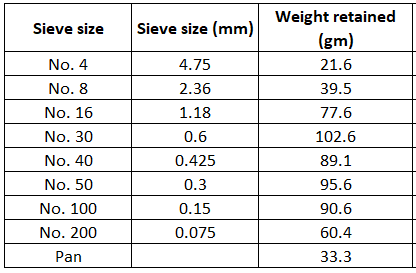Do the following: a) Calculate the percent retained and percent passing each sieve, and graph the results on a semi-log graph (you may use the attached chart, or graph in Excel and include with your submission). Then, characterize the gradation of the material. b) Calculate the values of D10, D30, D60, Cu, and Cc c) If the LL is 48 and the PL is 26, determine the USCS classification of the soil, and state its suitability for the purpose stated in the scenario.
Do the following: a) Calculate the percent retained and percent passing each sieve, and graph the results on a semi-log graph (you may use the attached chart, or graph in Excel and include with your submission). Then, characterize the gradation of the material. b) Calculate the values of D10, D30, D60, Cu, and Cc c) If the LL is 48 and the PL is 26, determine the USCS classification of the soil, and state its suitability for the purpose stated in the scenario.
Chapter2: Loads On Structures
Section: Chapter Questions
Problem 1P
Related questions
Question
Do the following:
a) Calculate the percent retained and percent passing each sieve, and graph the results on a semi-log graph (you may use the attached chart, or graph in Excel and include with your submission). Then, characterize the gradation of the material.
b) Calculate the values of D10, D30, D60, Cu, and Cc
c) If the LL is 48 and the PL is 26, determine the USCS classification of the soil, and state its suitability for the purpose stated in the scenario.

Transcribed Image Text:The table below presents the results from a sieve analysis performed on a sample of the top layer of soil. The sieve size is indicated in inches and the corresponding amount of soil retained is measured in grams.
| Sieve Size (in.) | 1/2 | 3/8 | No. 4 | No. 8 | No. 16 | No. 30 | No. 40 | No. 50 | No. 100 | No. 200 | pan |
|------------------|-----|-----|-------|-------|--------|--------|--------|--------|---------|---------|------|
| Amount retained (g) | 0 | 0 | 21.6 | 39.5 | 77.6 | 102.6 | 89.1 | 95.6 | 90.6 | 60.4 | 33.3 |
### Detailed Explanation:
- **Sieve Sizes**: The sieve sizes range from 1/2 inch to "pan", which generally collects the finest particles.
- **Amounts Retained**: The data shows varying amounts of soil retained by each sieve, with higher numbers generally indicating larger particle sizes. No soil was retained in the 1/2 and 3/8 inch sieves.
Such analyses are crucial for understanding soil composition, which can influence agricultural and construction outcomes.
Expert Solution
Step 1: Introduce the problem statement

Trending now
This is a popular solution!
Step by step
Solved in 6 steps with 10 images

Follow-up Questions
Read through expert solutions to related follow-up questions below.
Follow-up Question
What did you use for the axis y is the % finer but what is the x axis axis
Thank You
Solution
Knowledge Booster
Learn more about
Need a deep-dive on the concept behind this application? Look no further. Learn more about this topic, civil-engineering and related others by exploring similar questions and additional content below.Recommended textbooks for you


Structural Analysis (10th Edition)
Civil Engineering
ISBN:
9780134610672
Author:
Russell C. Hibbeler
Publisher:
PEARSON

Principles of Foundation Engineering (MindTap Cou…
Civil Engineering
ISBN:
9781337705028
Author:
Braja M. Das, Nagaratnam Sivakugan
Publisher:
Cengage Learning


Structural Analysis (10th Edition)
Civil Engineering
ISBN:
9780134610672
Author:
Russell C. Hibbeler
Publisher:
PEARSON

Principles of Foundation Engineering (MindTap Cou…
Civil Engineering
ISBN:
9781337705028
Author:
Braja M. Das, Nagaratnam Sivakugan
Publisher:
Cengage Learning

Fundamentals of Structural Analysis
Civil Engineering
ISBN:
9780073398006
Author:
Kenneth M. Leet Emeritus, Chia-Ming Uang, Joel Lanning
Publisher:
McGraw-Hill Education


Traffic and Highway Engineering
Civil Engineering
ISBN:
9781305156241
Author:
Garber, Nicholas J.
Publisher:
Cengage Learning